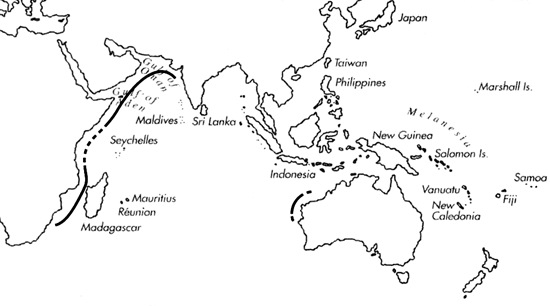
Skip Navigation Links
View access keys for this site.

Range: Gulf of Suez, Somalia, Persian Gulf, Gulf of Oman to the Makran coast of Pakistan; W. Australia (C. e. elegans); Natal to Mozambique (C. e. ramalhoi).
Description: Moderately small to medium sized, light to moderately solid. Last whorl narrowly conoid-cylindrical, to narrowly conical in subadults; outline slightly convex adapically, straight (right side) or slightly concave (left side) below. Shoulder angulate to carinate. Spire of moderate height to high, outline straight to slightly concave. Larval shell of 1.75-2.25 whorls, maximum diameter about 0.8 mm. First 5-7 postnuclear whorls tuberculate; suture deep and wide in first 2 whorls. Teleoconch sutural ramps slightly concave, with 2-3 increasing to 3-5 spiral grooves; spiral sculpture weak on latest ramps. Last whorl with punctate spiral grooves and flat ribbons between, mostly restricted to basal half, occasionally extending to shoulder. Surface sculpture weaker in C. e. ramalhoi.
| Shell Morphometry | ||
|---|---|---|
| L | 24-40 mm | |
| RW | 0.02-0.11 g/mm | |
| RD | 0.41-0.47 | |
| PMD | 0.77-0.85 | |
| (- 0.93 in subadults) | ||
| RSH | 0.18-0.28 | |
Ground colour white to beige in C. e. elegans (Pl. 57, Figs. 27-30), light violet in C. e. ramalhoi (Pl. 57, Figs. 31-34). In C. e. elegans, last whorl encircled with rows of orange to brown dots, irregular blotches and axial streaks, often forming interrupted spiral bands below shoulder and on both sides of centre. In C. e. ramalhoi, last whorl some times with a few brown blotches near centre and up to 16 evenly spaced spiral rows of variably numerous and arranged reddish brown dots, from base to shoulder. Larval shell white or light brown. In C. e. elegans, late sutural ramps usually with irregular brown blotches; sometimes brown subsutural dots present (Somalia). In C. e. ramalhoi, postnuclear sutural ramps with scattered light brown blotches; late ramps often with regularly spaced brown dots at both margins, regularly set below suture. Aperture white or light brown (Somalia) in C. e. elegans and orange to violet-brown in C. e. ramalhoi.
Periostracum light brown, semi-translucent in C. e. ramalhoi (Coomans et al., 1986).
Animal yellowish mottled with black, lacking an operculum and having relatively small radular teeth (C. e. ramalhoi; Ramalho, pers. comm., 1989). Animal white (C. e. elegans; Kauch, pers. comm., 1991).
Radular teeth small, of simple morphology; adapical fourth sharply pointed, without armature; serration absent; base with a spur (Rolán, pers. comm., 1993).
Habitat and Habits: Upper subtidal to about 60 m. C. e. elegans in 8-49 m in the Persian Gulf and in 9- 11 m along the Makran coast. C. e. ramalhoi in shallow water, on sheltered muddy sand flats in Angoche Bay (Grosch, pers. comm., 1989).
Discussion: C. aculeiformis differs from C. elegans in its lower spire (RSH 0.17-0.22), non-tuberculate postnuclear whorls, and its more conical last whorl (PMD 0.86- 0.95); its larval shell is broader (0.9-1 mm) and has more whorls (3-3.25). C. longurionis has also a broader larval shell (0.9-1 mm) of generally more whorls (2.25-3) and a more conical last whorl (PMD 0.83-0.90); its postnuclear sutural ramps are separated by deeper and wider sutures and have only 1 central spiral groove in first 3-5 or more whorls; the surface sculpture of its last whorl is more prominent. C. hopwoodi has a narrower last whorl (RD 0.37-0.43), often lower spire (RSH 0.18-0.24), and a broader larval shell (1 mm) with more whorls (3); its first 3 postnuclear sutural ramps bear 1 strong spiral groove rather than 2-3 fine grooves. C. milesi has a higher spire (RSH 0.29-0.38), a broader and more conical last whorl (RD 0.49-0.59; PMD 0.88-0.95), and its shoulder is tuberculate.

C. elegans range map
This section contains verbatim reproductions of the accounts of 316 species of Conus from the Indo-Pacific region, from Manual of the Living Conidae, by Röckel, Korn and Kohn (1995). They are reproduced with the kind permission of the present publisher, Conchbooks.
All plates and figures referred to in the text are also in Röckel, Korn & Kohn, 1995. Manual of the Living Conidae Vol. 1: Indo-Pacific Region.
The range maps have been modified so that each species account has it own map, rather than one map that showed the ranges of several species in the original work. This was necessary because each species account is on a separate page on the website and not confined to the order of accounts in the book.
Return to framed version (returns to search page)